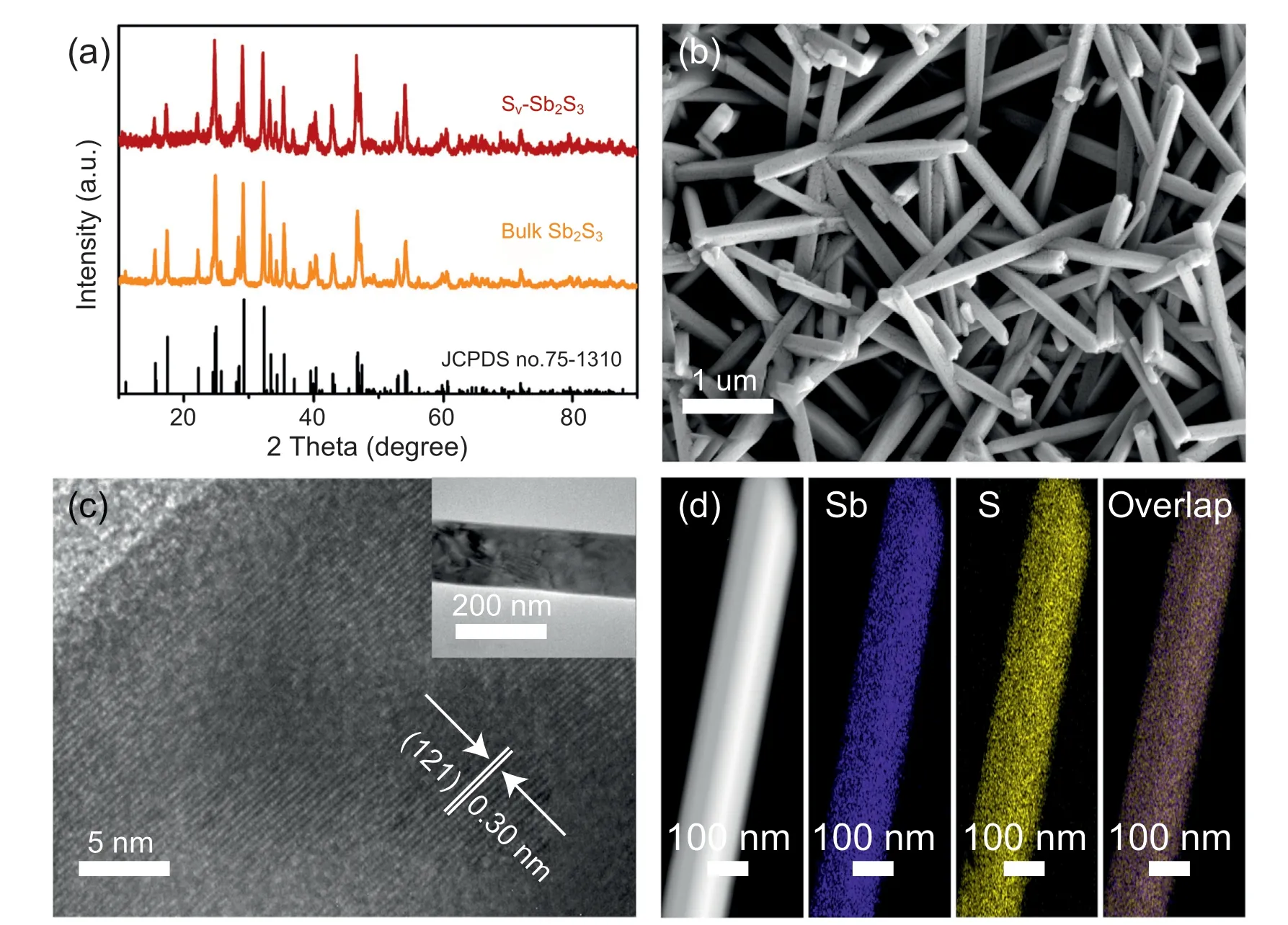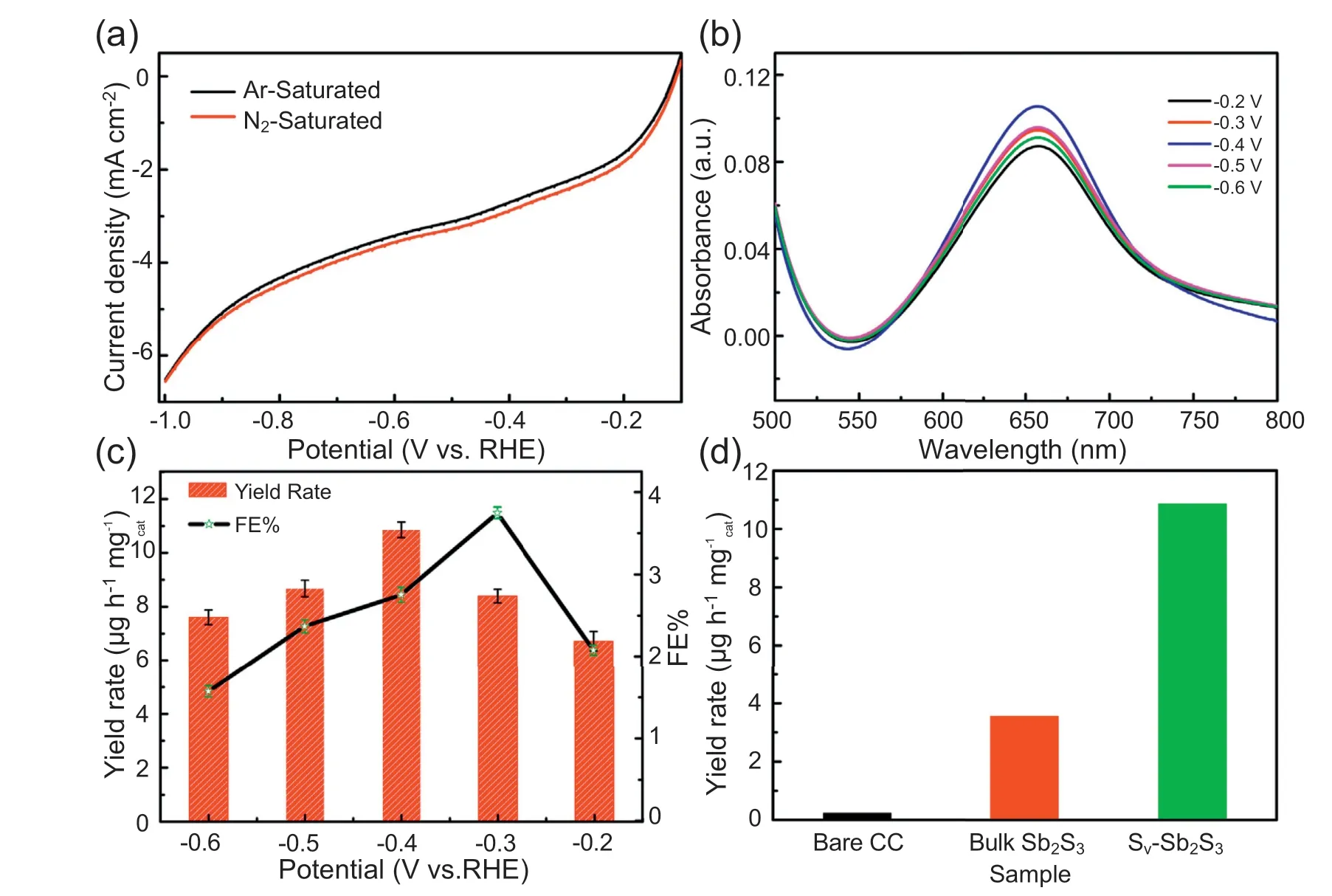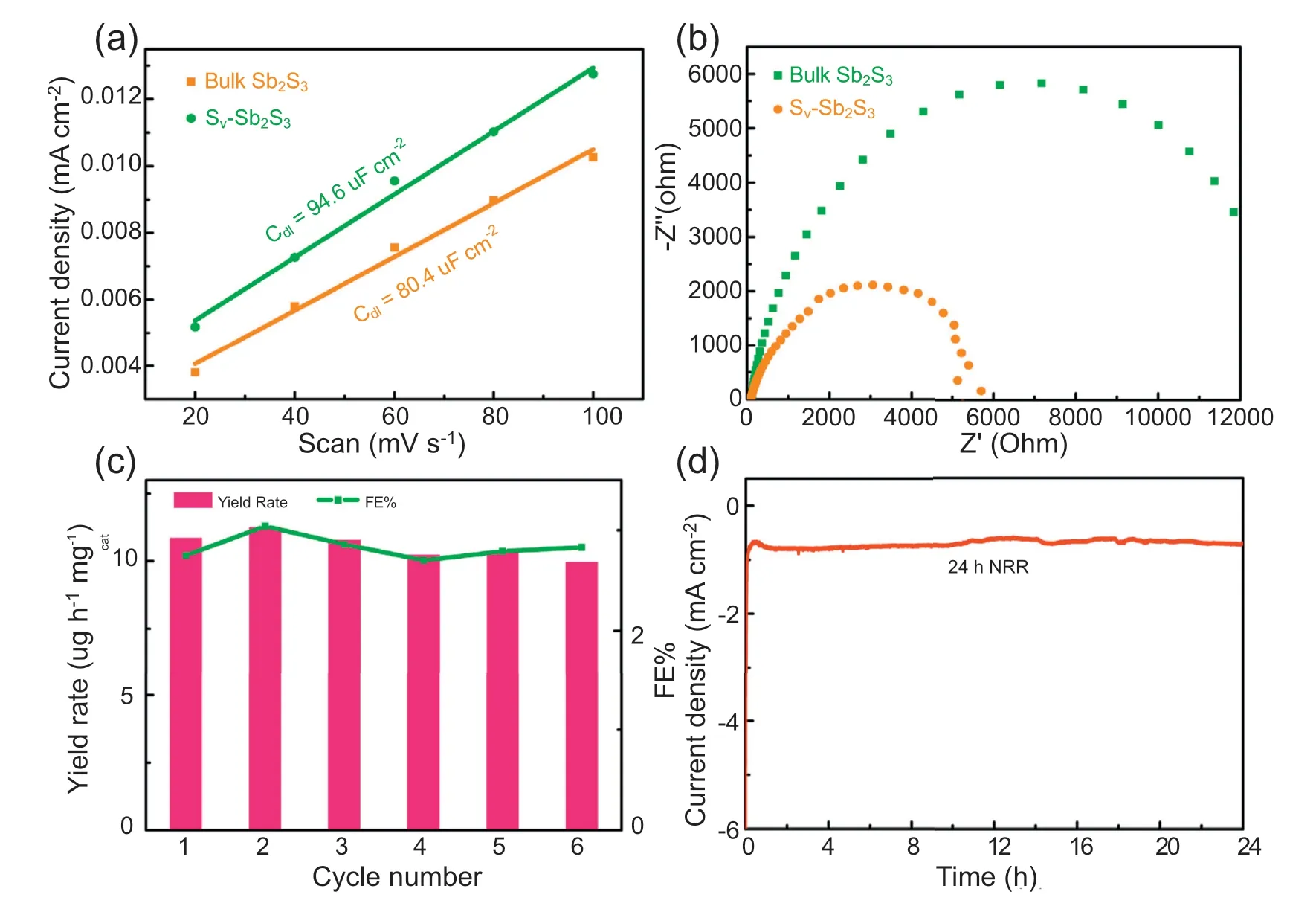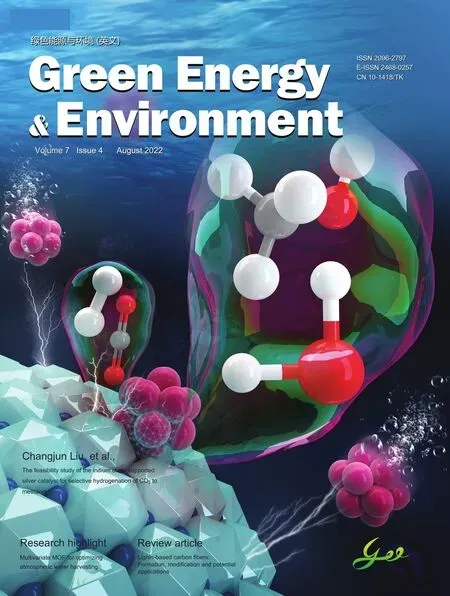Sulfur vacancies-doped Sb2S3 nanorods as high-efficient electrocatalysts for dinitrogen fixation under ambient conditions
Xuyn Wng,Jinwei Bi,Ynto Wng,Xioying Lu,Zehu Zou,Junfeng Hung,Ciling Xu,
a State Key Laboratory of Applied Organic Chemistry,Laboratory of Special Function Materials and Structure Design of the Ministry of Education,College of Chemistry and Chemical Engineering,Lanzhou University,No.222 Tianshui South Road,Lanzhou,730000,China
b Lanzhou No.11 Middle School,No.523 Pingliang Road,Lanzhou,730000,China
Abstract Tuning surface electron transfer process by sulfur (S)-vacancies engineering is an efficient strategy to develop high-efficient catalysts for electroreduction N2 reaction (NRR).Herein,the distinct Sb2S3 nanorods with S-vacancies (Sv-Sb2S3) have been synthesized by a simple twostep method including hydrothermal and hydrogenation in H2/Ar atmosphere,which shows improved performance for NRR with the NH3 yield rate of 10.85 μg h-1at-0.4 V vs.RHE,the faradaic efficiency(FE)of 3.75%at-0.3 V vs.RHE and excellent stability for 24 h,largely outperforming bulk Sb2S3.X-ray photoelectron spectroscopy (XPS) and density function theory (DFT) calculations demonstrate that the abundant S-vacancies can create an electron-deficient environment and modulate the electron delocalization in Sv-Sb2S3,which can not only facilitate the N2 molecule adsorption,but also activate the N≡N,resulting in the enhanced performance for NRR.
Keywords: Electrocatalyst;N2 electroreduction reaction;Vacancies;Defect engineering
1.Introduction
It is well known that ammonia (NH3) is one of the most valuable industrial chemicals for modern industry and agriculture.NH3has played a significant role to serve as a primary material of fertilizers,a potential hydrogen storage material and newly-developing renewable fuel in human being and social development [1-3].Hitherto,Haber-Bosch process has been used intensively for the industrial production of NH3,which is achieved on an iron-based catalyst under rigorous conditions (300-500°C,20-40 MPa) [4].The Haber-Bosch process is highly energy-intensive,which will consume more than 1% annual global energy and result in significant greenhouse gas emission [5-7].Given that the energy consumption during this process and big development perspective of NH3in future energy application systems is increasingly great,electrocatalytic nitrogen reduction reaction (NRR) in which nitrogen molecule is reduced by electrons and protons at ambient conditions have been attracting enormous attentions owing to the energy-saving,environmentally friendly and benign characteristic.What's more,the NRR system is more easily integrated to renewable energy,such as solar and wind[8,9].However,the sluggish dynamic of NRR and low dissolved nitrogen concentration lead to relatively low yield rate and Faradaic efficiency of NH3synthesis [4,10].Hence,it is urgently needed to explore ideal NRR electrocatalysts for the N2absorption and activation.
At present,the noble metal-based electrocatalysts such as Au [11,12],Pd [13,14],Ru [15,16] exhibit superior NRR activity,but they are restricted in the wide applications due to the high price and scarcity.Instead,tremendous interests have been drawn on the non-noble metal oxides [17],sulfides [18-20],nitrides [21,22] and nonmetallic materials [23-25].Although some prolific achievements have been made to enhance the NRR performance,seeking for high-efficient electrocatalysts is still a great challenge to produce NH3in a significant yield.According to Wang's work,the black phosphorus nanosheets exhibited excellent electrocatalytic activity for NRR,which was attributed to the similar valence electron structure of phosphorus with nitrogen [23].As the same main group (ⅤA) element,the valence electron structure of Sb is also similar to that of nitrogen.Therefore,Sb2S3maybe a prospective candidate for NRR,which has been widely used as a negative electrode material for sodium-ion batteries owing to the outstanding thermal,electrical,optical and mechanical properties [26-28].For example,Ding's group reported the improved NRR performance of Sb2S3/SnO2heterostructure[29].Unfortunately,only fewer works have been made to research the N2fixation ability of pure Sb2S3.
As previously reported,single-sulfides don't have outstanding catalytic properties,which is mainly due to slow charge migration kinetics or low quantum efficiency [30].In order to figure out these problems,one feasible strategy is vacancy engineering to enhance the electrocatalytic activity of catalysts by modulating the electronic properties of electrocatalysts [31].Especially,the latest reports demonstrate that defect engineering exert a greater influence on the enhancement of NRR performance.For example,Cu doped CeO2with multiple oxygen vacancies fabricated by Zhang and coworkers shows good activity for electrocatalytic N2reduction to NH3due to the multiple oxygen vacancies formed around Cu sites[32].Ye and coworkers demonstrated by DFT calculations that Ta2O5with oxygen vacancies can sharply increase the bond length of N≡N triple bond due to the electron back-donation process between Ta atoms adjacent to oxygen vacancy and adsorbed N2molecule [33].Conductive and elastic TiO2nanofibrous aerogels exhibited superior electrocatalytic NRR performance due to the abundant oxygen vacancies [34].SnO2-xwith rich oxygen vacancies also shows the excellent activity for NRR [35].Li's group reported that the N-doped MoS2nanoflowers with sulfur vacancies make a great enhancement during electrochemical reduction of N2to NH3because sulfur vacancies can effectively enhance the N2activation,facilitate the electron transfer,and further boost the NRR activity [36].In theory,the properties of NRR can be boosted when the N2adsorption capacity and activation are improved.The S-S bonds become unsaturated in principle when S atoms are removed from the sulfides,generating S vacancies.The formed vacancies can improve the N2adsorption capacity due to the unshared pair electrons of N2[37].Therefore,the design of sulfide catalyst with vacancies is a potential strategy to facilitate the N2electrochemical reduction performance,which will modulate the N2adsorption.It is anticipated that the favorable N2adsorption on vacancies engineered sulfides are also of great prospects for NRR yet formidable challenges.
Inspired by the above consideration,Sb2S3nanorods with abundant sulfur vacancies (denoted as Sv-Sb2S3) were preppared by a simple hydrothermal and hydrogenation method in H2/Ar atmosphere.Sv-Sb2S3nanorods could achieve the enhanced NH3yield rate,faradaic efficiency (FE) and excellent stability.The theoretical calculation results further confirm that sulfur vacancies increase the electron delocalization in the system of Sb2S3,which is responsible for N2adsorption.At the same time,the electron redistribution induced by sulfur vacancies will make the increased electron density of Sb atom,which will donate the electrons to the empty antibonding orbitals of adsorbed N2for the N≡N activation.Hence,this work may provide useful insights and new directions for the design of Sb2S3and their application for electrocatalytic nitrogen reduction.
2.Experimental section
2.1.Materials
Antimony trichloride (SbCl3),L-cysteine,sodium sulfide nonahydrate (Na2S·9H2O),ammonium chloride (NH4Cl),sodium hydroxide (NaOH),salicylic acid (C7H6O),trisodium citrate dihydrate (C6H5Na3O7·2H2O),sodium hypochlorite solution (NaClO 5.5 wt%),sodium nitroprusside dihydrate(Na2[Fe(CN)5NO] 2H2O),hydrazine monohydrate,para-(dimethylamino)benzaldehyde(C9H11NO),concentrated HCl,ethanol and sodium sulfate anhydrous (Na2SO4) were all of analytical grade and were directly used without any additional purification.Nafion solution (5 wt%) was purchased from Sigma Aldrich.Carbon cloth was purchased from the J &K Chemical Technology and washed sequentially with acetone,ethanol and water before using.All aqueous solutions used in this work are prepared by ultrapure water (>18 MΩ cm-1)from a Millipore system.
2.2.Synthesis of bulk Sb2S3
Bulk Sb2S3was prepared via a facile hydrothermal method.Firstly,SbCl3(0.912 g),L-cysteine (0.500 g) and Na2S·9H2O(1.920 g) were dissolved in 60 mL deionized water under vigorous stirring for 3 h to make the homogeneous solution.Subsequently,the solution was transferred into a 100 mL Teflon-lined stainless steel autoclave and heated at 180°C for 12 h.Finally,the product was washed using water and ethanol when it cooled to room temperature naturally and then dried at 60°C in air.
2.3.Synthesis of sulfur vacancies-doped Sb2S3 (denoted as Sv-Sb2S3)
To obtain sulfur vacancies-doped Sb2S3,the resulting Sb2S3power was grinded uniformly and put in a quartz boat at the middle of the furnace and then annealed at 250°C for 3 h(the ramping rate of temperature is 5°C min-1)in the atmosphere of H2/Ar (H2Vol.ratio is 5%).
2.4.Preparation of working electrode for electrochemical N2 reduction reaction(NRR)
5 mg catalysts and 40 μL Nafion solution were dispersed in 960 μL ethanol under ultrasonic for 1 h to form a homogeneous ink.Then 40 μL catalyst ink was dropped on a piece of 1 cm × 1 cm carbon cloth and then dried under an infrared lamp for several minutes.The real area of carbon cloth electrode is 1 cm×2 cm and the immersing area in the electrolyte was 1 cm×1 cm with a loading of 0.2 mg cm-2for catalyst.The current density in carbon cloth was normalized to the geometric surface area of working electrode (1 cm2).
3.Results and discussion
3.1.Morphology and structure of catalysts
As ascribed in the illustration of Scheme 1,the Sv-Sb2S3electrocatalyst was synthesized through two steps.Firstly,the bulk Sb2S3nanorods were constructed by a simple hydrothermal method.Finally,Sb2S3nanorods with abundant sulfur vacancy(Sv-Sb2S3)were prepared by heat treating bulk Sb2S3nanorods under the flow of H2/Ar.

Scheme 1.An illustration of the preparation of Sv-Sb2S3.
Fig.1a shows the XRD patterns of as-synthesized bulk Sb2S3and Sv-Sb2S3.All the diffraction peaks of bulk Sb2S3and Sv-Sb2S3are matched well with the standard diffraction pattern of orthorhombic stibnite (JCPDS No.75-1310).The obtained XRD results demonstrate the high crystallinity and purity of the as-synthesized Sb2S3samples.As shown in Fig.1b and S1a,both Sv-Sb2S3and bulk Sb2S3show the homogeneous rod-like morphology with the diameter about 200 nm.Similarly,the lattice distance of 0.30 nm and 0.51 nm can be indexed to (121) lattice plane of Sv-Sb2S3and (120) lattice plane of bulk Sb2S3,respectively (Fig.1c and S1c).Energy-dispersive X-ray (EDX) mapping images demonstrate the uniform distribution of Sb and S elements in bulk Sb2S3and Sv-Sb2S3,as shown in Fig.1d and S1d.Above results indicate that the crystal structure and morphology of Sb2S3display unchanged during the hydrogenation process.
The chemical composition and valence state of as-synthesized bulk Sb2S3and Sv-Sb2S3are characterized by X-ray photoelectron spectroscopy (XPS).The XPS survey spectra prove the existence of Sb and S in Sv-Sb2S3and bulk Sb2S3(Fig.2a).As shown in Fig.2b,the main peaks at 538.52 eV and 529.13 eV for bulk Sb2S3can be assigned to the Sb 3d3/2and Sb 3d5/2peaks,respectively,which suggests the presence of Sb3+[38],while the peaks at 533.16 eV and 531.85 eV are responding to the adsorbed H2O and lattice O2-bound to Sb,respectively,which may result from the slight oxidation of Sb2S3[39].Compared with the bulk Sb2S3,the Sb 3 d peaks of Sv-Sb2S3shows a slight shift (~0.1 eV) to the low binding energy,indicating the increased electron cloud density around Sb.Fig.2c is the high-resolution S 2p spectra,in which two peaks located at 162.15 eV and 160.97 eV for bulk Sb2S3are attributed to the spin orbit components of 2p1/2and 2p3/2of S2-[40].Compared to bulk Sb2S3,the S 2p3/2(161.40 eV)and S 2p1/2(162.51 eV) of Sv-Sb2S3shift to the high binding energy,which indicates the electron transfer from S to Sb atoms induced by the introduction of sulfur vacancies [30].In addition,the calculated ratio of S and Sb from the XPS spectra in Sv-Sb2S3(0.63)is much smaller than that of the bulk Sb2S3(1.10),indicating the presence of sulfur vacancies in the Sv-Sb2S3[41].Sulfur vacancies can be also evidenced by electron paramagnetic resonance (EPR) spectra at low temperature because EPR can give the direct information about diverse behaviors of native defects,such as oxygen or sulfur vacancies[42].As shown in Fig.2d,no obvious EPR signal is measured for bulk Sb2S3,while the as-prepared Sv-Sb2S3shows a strong resonance signal at g=2.005,suggesting the abundant sulfur vacancies[43].In other words,the rich sulfur vacancies can be in-situ generated by hydrogenation of bulk Sb2S3.The presence of sulfur vacancies can modify the electronic structure of Sb2S3,which will not only facilitate the electron transport along the surface of Sb2S3catalysts,but also activate N2and lower the reaction energy barrier [36-44].Therefore,the rich sulfur vacancies will be beneficial for the improvement of NRR performance of bulk Sb2S3.
3.2.Electrocatalytic N2 reductionperformance ofcatalysts

Fig.1.(a) XRD patterns of Sv-Sb2S3 and bulk Sb2S3.(b) SEM (c) HRTEM (the inset is TEM image) and (d) EDX mapping images of Sv-Sb2S3.

Fig.2.(a)XPS survey spectra of bulk Sb2S3 and Sv-Sb2S3.High-resolution XPS spectra of(b)Sb 3 d and(c)S 2p for bulk Sb2S3 and Sv-Sb2S3.(d)EPR spectra of bulk Sb2S3 and Sv-Sb2S3.

Fig.3.(a) LSV of Sv-Sb2S3 in Ar-saturated and N2-saturated 0.1 mol L-1 Na2SO4 solution.(b) UV-Vis absorption of the electrolytes stained with indophenol indicator after electrolysis using Sv-Sb2S3 as catalysts at different potentials for 2 h.(c)NH3 yield rates and FEs at different potentials for Sv-Sb2S3.(d)NH3 yield rates for different electrocatalysts at -0.4 V for 2 h electrolysis under ambient conditions.
The linear sweep voltammetry(LSV)in N2-saturated and Ar-saturated 0.1 mol L-1Na2SO4solution were carried out to evaluate the electrocatalytic activities of Sv-Sb2S3.As shown in Fig.3a,the current density displayed by Sv-Sb2S3in N2-saturated solution is obviously higher than that in Arsaturated solution in the range of potentials,manifesting that Sv-Sb2S3possesses the effective electrocatalytic activity for N2reduction.The chronoamperometry curves of Sv-Sb2S3tested at different potentials (Fig.S4) show the constant current density in the period of 2 h,indicating their excellent stability for N2reduction.Fig.3b is the ultraviolet-visible(UV-Vis) absorption spectra of the cor111responding electrolytes colored for 2 h using indophenol indicator at dark environment.It can be seen that the obtained electrolyte at-0.4 V vs.RHE for Sv-Sb2S3show the strongest absorption,indicating the highest NH3yield at the applied potential of-0.4 V vs.RHE (Fig.3b).Fig.3c shows that the NH3yield rate for Sv-Sb2S3continuously increases until the applied potential reaches -0.4 V vs.RHE and the FE is increasing with the decreased potential when the potential reaches-0.3 V vs.RHE.The optimal yield rate is 10.85 μg h-1which is well superior to bare CC(0.075 μg h-1cm-2),bulk Sb2S3(3.86 μg h-1)(Fig.4d) and previous reported electrocatalysts (Table S1),including BCN nanosheets (7.75 μg h-1) [4],Ag nanosheets (2.33 μg h-1) and so on [45].The FE obtained at -0.4 V vs.RHE is 3.75%.In addition,the main by-product (N2H4) is not detected in the above electrolytes(Fig.S5),demonstrating the excellent selectivity toward NRR for Sv-Sb2S3.Furthermore,some control experiments are carried out to prove the derivation of the detected NH3.As shown in Fig.S6,all the electrolytes obtained under different experiment conditions display very weak absorption,demonstrating that the detected NH3comes from the electrocatalytic N2reduction at -0.4 V vs.RHE.
To better investigate the reasons for the enhanced NRR performance of Sv-Sb2S3,the electrochemical active surface areas (ECSAs) of bulk Sb2S3and Sv-Sb2S3are measured,respectively.The ECSAs is directly proportional to electrochemical double-layer capacitance(Cdl)[46,47],which can be determined through cyclic voltammetry measurement(Fig.S8).Apparently,the Sv-Sb2S3possesses a little higher Cdl(94.6 μF cm-2) than bulk Sb2S3(80.4 μF cm-2) (Fig.4a).Furthermore,Brunauer-Emmett-Teller (BET) tests (Fig.S7)indicate that the overall specific surface area of Sv-Sb2S3is 8.28 m2g-1,which is slightly higher than that of bulk Sb2S3(8.17 m2g-1).So the introduction of sulfur vacancies makes negligible difference of ECSAs and BET surface area for bulk Sb2S3and Sv-Sb2S3,indicating that the sulfur vacancies in Sb2S3nanorods is the dominant factor for the enhanced intrinsic activity of Sv-Sb2S3for NRR.Furthermore,the EIS spectra of Sv-Sb2S3and bulk Sb2S3shows the smaller charge transfer resistance of Sv-Sb2S3compared with bulk Sb2S3(Fig.4b),which make for the effective electron transfer [36].As previously reported,the abundant sulfur vacancies can enhance the intrinsic conductivity of electrocatalysts,which is beneficial for the N2absorption and activation of the N≡N bond during NRR process [32,36].

Fig.4.(a)Difference of current density at 0.05 V vs.RHE as a function of the scan rate.(b)EIS spectra of bulk Sb2S3 and Sv-Sb2S3.(c)NH3 yield rates and FEs for 6 times recycling tests at -0.4 V vs.RHE.The time of each cycle is 2 h.(d) Time-dependent current density curve of Sv-Sb2S3 at -0.4 V for 24 h.

Fig.5.(a)DOS and orbital projected-DOS for structures of bulk Sb2S3(left panel)and Sv-Sb2S3(right panel).(b)Electron localization function of bulk Sb2S3(left panel) and Sv-Sb2S3 (right panel).(c) A schematic drawing of the crystal structures of bulk Sb2S3 and Sv-Sb2S3.
The electrochemical durability is another significant assessment parameter for NRR catalysts.Firstly,recycling experiments for 6 times have been carried out at -0.4 V(Fig.S9).The cor111responding NH3yield rate and FE are shown in Fig.4c.As shown in Fig.4c,the change of NH3yield rate and FE is negligible during the recycling tests.Furthermore,the consecutive I-t test for Sv-Sb2S3is performed at-0.4 V vs.RHE for 24 h(Fig.4d).It can be seen that there is an ignorable fluctuation for the current density in a period of 24 h.At the same time,no change can be found for the TEM and HRTEM image of Sv-Sb2S3after recycling stability test (Fig.S10).All these results demonstrate the excellent stability of Sv-Sb2S3,which is highly desired for the practical application of NRR electrocatalysts.
3.3.DFT calculation
To further acquire in-depth understanding about the vacancy effect,DFT calculation was performed.Fig.5a shows the calculated DOS of bulk Sb2S3and Sv-Sb2S3.The DOS values indicate that the conduction bands are primarily dedicated by p-states of Sb,while the valence bands are mostly contributed to the mixture of p-Sb states and p-S states in bulk Sb2S3.However,a new electronic state is observed at the Fermi level accompanying the introduction of sulfur vacancies,which is named defect energy level.The defect energy level is mainly contributed by the 2p electrons of S atoms.The introduction of defect energy level can shorten the band gap,which is responsible for the improved conductivity of Sv-Sb2S3.The electron localization function (Fig.5b)further demonstrates the electron delocalization in Sv-Sb2S3is enhanced,which is modulated by the sulfur vacancies [30].Therefore,the electron cloud density around Sb atoms will increased and the deficient electron around S atoms,as described in XPS results.Detailed information about delocalization are shown in Table S2.As a result,on the one hand,the electron-deficient environment around S atoms will accommodate the lone-pair electrons of N2molecule to facilitate the N2adsorption,on the other hand,the rich electrons on adjacent Sb atoms are transferred to the empty antibonding orbitals of adsorbed nitrogen due to the electron backdonation process,which can intensively weaken the N≡N triple bond to further activate the adsorbed N2[48].
4.Conclusions
In conclusion,we have successfully constructed S-vacancies engineered Sb2S3for highly efficient NRR by a facile two-step method including hydrothermal and hydrogenation in H2/Ar atmosphere.In comparison to bulk Sb2S3nanorods,the Sv-Sb2S3exhibit the enhanced NRR electrocatalytic performance in Na2SO4electrolyte with a NH3yield rate of 10.85 μg h-1at -0.4 V vs.RHE,a faradaic efficiency(FE) of 3.75% at -0.3 V vs.RHE and a good long-term stability with the stable current density during chronoamperometry test for 24 h.XPS analysis shows that the sulfur vacancies in Sb2S3lead to the electron transfer from S to Sb atoms.DFT calculations further indicates that the sulfur vacancies not only create a new defect energy level,but also give rise to the enhanced electron delocalization.All the results boost the improved conductivity of Sv-Sb2S3,the facilitating adsorption of N2molecular and the activation of the absorbed N2.Therefore,this work may open up a new avenue to develop the promising NRR catalysts.
Conflict of interest
The authors declare that they have no conflict of interest.
Acknowledgments
This work was supported by Natural Science Foundation of China (NSFC no.21673105)and the Science and Technology Program of Gansu Province of China (Grant No.1717JR5RA194).We also thank the Electron Microscopy Centre of Lanzhou University for the TEM results.
Appendix A.Supplementary data
Supplementary data to this article can be found online at https://doi.org/10.1016/j.gee.2020.11.016.
 Green Energy & Environment2022年4期
Green Energy & Environment2022年4期
- Green Energy & Environment的其它文章
- Multivariate MOF for optimizing atmospheric water harvesting
- Lignin-based carbon fibers: Formation,modification and potential applications
- Charactering and optimizing cathode electrolytes interface for advanced rechargeable batteries: Promises and challenges
- Metal-organic frameworks-derived metal phosphides forelectrochemistry application
- Surface-mediated iron on porous cobalt oxide with high energy state for efficient water oxidation electrocatalysis
- Oxygen-deficient SnO2 nanoparticles with ultrathin carbon shell for efficient electrocatalytic N2 reduction
